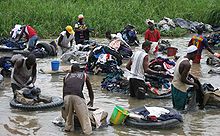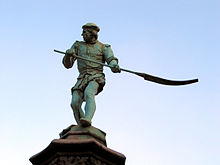- Laundry
-
Laundry hanging out of flats for drying in Bukit Batok, Singapore.

Laundry is a noun that refers to the act of washing clothing and linens, the place where that washing is done, and/or that which needs to be, is being, or has been laundered. Laundry can be considered a room or area, as in a home or apartment building, reserved for doing the family wash.
Contents
Laundry
The launderer by Jef Lambeaux.
 Laundry in the river in contemporary Abidjan, Ivory Coast.
Laundry in the river in contemporary Abidjan, Ivory Coast. Irreler Bauerntradition shows the history of laundry at the Roscheider Hof Open Air Museum
Irreler Bauerntradition shows the history of laundry at the Roscheider Hof Open Air Museum
Laundry was first done in watercourses[citation needed], letting the water carry away the materials which could cause stains and smells. Laundry is still done this way in some less industrialized areas and rural regions. Agitation helps remove the dirt, so the laundry is often rubbed, twisted, or slapped against flat rocks. Wooden bats or clubs could be used to help with beating the dirt out. These were often called washing beetles or bats and could be used by the waterside on a rock (a beetling-stone), on a block (battling-block), or on a board. They were once common across Europe and were also used by settlers in North America. Similar techniques have also been identified in Japan.
Various chemicals may be used to increase the solvent power of water, such as the compounds in soaproot or yucca-root used by Native American tribes, or the ash lye once widely used for soaking laundry in Europe. Soap, a compound made from lye and fat, is an ancient and common laundry aid. Modern washing machines typically use powdered or liquid laundry detergent in place of more traditional soap.
When no watercourses were available, laundry was done in water-tight vats or vessels. Sometimes large metal cauldrons were filled with fresh water and heated over a fire; boiling water was even more effective than cold in removing dirt. Wooden or stone scrubbing surfaces set up near a water supply or portable washboards, including factory-made corrugated metal ones, gradually replaced rocks as a surface for loosening soil.
Once clean, the clothes were wrung out — twisted to remove most of the water. Then they were hung up on poles or clotheslines to air dry, or sometimes just spread out on clean grass.
The Industrial Revolution
The Industrial Revolution completely transformed laundry technology.
The mangle (wringer US) was developed in the 19th century — two long rollers in a frame and a crank to revolve them. A laundry-worker took sopping wet clothing and cranked it through the mangle, compressing the cloth and expelling the excess water. The mangle was much quicker than hand twisting. It was a variation on the box mangle used primarily for pressing and smoothing cloth.
Meanwhile 19th century inventors further mechanized the laundry process with various hand-operated washing machines. Most involved turning a handle to move paddles inside a tub. Then some early 20th century machines used an electrically powered agitator to replace tedious hand rubbing against a washboard. Many of these were simply a tub on legs, with a hand-operated mangle on top. Later the mangle too was electrically powered, then replaced by a perforated double tub, which spun out the excess water in a spin cycle.
Laundry drying was also mechanized, with clothes dryers. Dryers were also spinning perforated tubs, but they blew heated air rather than water.
Chinese laundries in North America
See also: Yick Wo v. HopkinsIn the United States and Canada in the late 19th and early 20th century, the occupation of laundry worker was heavily identified with Chinese Americans. Discrimination, lack of English-language skills, and lack of capital kept Chinese Americans out of most desirable careers. Around 1900, one in four ethnic Chinese men in the U.S. worked in a laundry, typically working 10 to 16 hours a day.[1] [2]
New York City had an estimated 3,550 Chinese laundries at the beginning of the Great Depression of the 1930s. In 1933, with even this looking to many people like a relatively desirable business, the city's Board of Aldermen passed a law clearly intended to drive the Chinese out of the business. Among other things, it limited ownership of laundries to U.S. citizens. The Chinese Consolidated Benevolent Association tried fruitlessly to fend this off, resulting in the formation of the openly leftist Chinese Hand Laundry Alliance (CHLA), which successfully challenged this provision of the law, allowing Chinese laundry workers to preserve their livelihoods.[1]
The CHLA went on to function as a more general civil rights group; its numbers declined strongly after it was targeted by the FBI during the Second Red Scare (1947–1957).[1]
Apartments in developed countries
In some parts of the world, including Europe and North America, apartment buildings and dormitories often have laundry rooms, where residents share washing machines and dryers. Usually the machines are set to run only when money is put in a coin slot. They turn on when the money is inserted and they run for as long as you pay.
In other parts of the world, apartment buildings with laundry rooms are uncommon, and each apartment may have its own washing machine. Those without a machine at home or the use of a laundry room must either wash their clothes by hand or visit a commercial laundromat.
Right to Dry Movement
Some organizations have been campaigning against legislation which has outlawed line-drying of clothing in public places, especially given the increased greenhouse gas emissions produced by clothes dryers.[citation needed]
Legislation making it possible for thousands of American families to start using a clothesline in communities where they were formerly banned was passed in Colorado in 2008. In 2009, clothesline legislation was debated in several states, including Connecticut, Hawaii, Maryland, Maine, New Hampshire, Nebraska, Oregon, Virginia, and Vermont. Other states are considering similar bills.[citation needed]
Although there are homeowners' associations and other communities in the United States that prohibit residents from using a clothesline outdoors, or limit its use to locations that are not visible from the street or to certain times of day, other communities expressly prohibit rules that prevent the use of clotheslines. Florida is the only state to expressly guarantee a right to dry, although Utah and Hawaii have passed solar rights legislation.
In Florida, a law states that "No deed restrictions, covenants, or similar binding agreements running with the land shall prohibit or have the effect of prohibiting solar collectors, clotheslines, or other energy devices based on renewable resources from being installed on buildings erected on the lots or parcels covered by the deed restrictions, covenants, or binding agreements".[3] No other state has such explicit legislation[citation needed]. Vermont considered a "Right to Dry" bill in 1999, but it was defeated in the Senate Natural Resources & Energy Committee. The language has been included in a 2007 voluntary energy conservation bill, introduced by Senator Dick McCormack. Similar measures are being introduced in some parts of Canada, including the province of Ontario, as well.[citation needed]
Common problems
Novice users of modern laundry machines sometimes experience accidental shrinkage of garments, especially when applying heat. For wool garments, this is due to scales on the fibers which heat and agitation cause to stick together. Other fabrics are stretched by mechanical forces during production, and can shrink slightly when heated (though to a lesser degree than wool). Some clothes are "pre-shrunk" to avoid this problem.[4]
Another common problem is color bleeding. For example, washing a red shirt with white underwear can result in pink underwear. Often only like colors are washed together to avoid this problem, which is lessened by cold water and repeated washings.
Laundry symbols are included on many clothes to help consumers avoid these problems.
See also
- Laundry symbols
- Washing machine
- Tunnel washer
- Clothes dryer
- Drying cabinet
- Drying rack
- Ironing
- Household chore
- Laundromat
- Industrial laundry
Notes
- ^ a b c "Yung, Judy; Chang, Gordon H.; Lai, Him Mark, eds. (2006), "Declaration of the Chinese Hand Laundry Alliance.", Chinese American Voices, University of California Press, pp. 183–185 (including notes), ISBN 0-520-24310-2
- ^ Ban Seng Hoe (2004), Enduring Hardship: The Chinese Laundry in Canada, Canadian Museum of Civilization, ISBN 0-660-19078-8
- ^ "Energy devices based on renewable resources". The 2008 Florida Statutes. 163.04. Florida Senate. 2008. http://www.flsenate.gov/statutes/index.cfm?App_mode=Display_Statute&URL=Ch0163/SEC04.HTM&Title=-%3E2008-%3ECh0163-%3ESection%2004#0163.04.
- ^ "Why Clothes Shrink". http://www.npr.org/templates/transcript/transcript.php?storyId=98759520.
External links
- Coin Laundry Association, a not-for-profit trade organization serving the self-service laundry industry
- Latest Laundry Technologies (video)
- Project Laundry List,[ a 501c3 non-profit which campaigns to make air-drying laundry acceptable and desirable as a simple and effective way to save energy.]
Categories:- Laundry
- Home appliances
Wikimedia Foundation. 2010.




